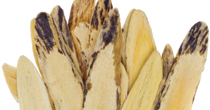Astragalus for
Immunity © 2010
by Joe Smulevitz, CH, MH

Are you accustomed to taking echinacea at the first sign of a cold or flu to stimulate the immune system? Did you know that in Traditional Chinese Medicine (TCM), astragalus root (Astragalus membranaceus) is used like echinacea to help prevent colds and flu, but it’s also very different? Astragalus helps the body to resist colds, and renew both energy and vitality once an illness is finished. It can be taken as a long-term tonic to boost the immune system, unlike echinacea that should only be used short term. Scientific evidence also suggests that astragalus may strengthen the immune system of cancer patients.
Research indicates there are different ways in which astragalus provides immune enhancement: it stimulates the production of interferon, an antiviral agent produced by the body, which inhibits the ability of viruses to reproduce; it increases the levels of immunoglobulins, or antibodies, to combat infections or other foreign substances; it increases levels of natural killer cells, which seek out and destroy a wide variety of invaders, including virus-infected body cells; and it steps up the production of macrophages, large white blood cells which engulf foreign matter that has entered the body.
There are approximately 2,000 species of astragalus worldwide. The species used for its immune-enhancing ability, Astragalus membranaceus, has been extensively studied in the Orient. Astragalus is the common English name for huang qi in Chinese. Huang refers to the yellow internal colour of the root, while qi means leader, suggesting its status as a superior tonic herb in TCM, where it is used in teas, soups, extracts, and pill form. Astragalus is thought to strengthen a person’s “vital energy” or wei qi, the body’s defensive energy (immune system) that protects against invading pathogens (viruses and bacteria). This protective energy circulates just under the skin, and helps the body adapt to heat, cold, humidity, and wind. If wei qi is deficient, blocked, or exhausted these environmental forces will penetrate and injure the flesh, blood, and inner organs, resulting in lower resistance to disease, reduced stamina, and endurance.
The history of astragalus dates back two thousand years, first described in an ancient Chinese herbal, Shen Nong Ben Cao Jing, considered as one of the premier classic works in Chinese Medicine. Its use, generally combined with other herbs, such as ginseng, angelica, and licorice, grew from Northern China, and cultivation extended to much of the remainder of China and Mongolia. The herb became valued in the Orient as a treatment for sweating, diabetes, respiratory diseases, stomach ulcers, poor appetite, fatigue, weak digestion, frequent colds, as well as a heart tonic. Herbalists in the West did not use astragalus until the 1800s as an ingredient in different tonics. The herb still remained relatively unknown in North America until the 1980s. Its popularity grew when researchers at the M. D. Anderson Cancer Center (Houston, Texas) performed a number of clinical and laboratory studies with astragalus. They found that extracts of astragalus restored the function of T-cells (white blood cells that orchestrate an immune response) in the majority of cancer patients studied.
In contemporary Chinese medicine, astragalus is an important part of fu zheng therapy which helps support the body’s natural balance by counteracting the immune-compromising effects of chemotherapy and radiation. Several studies carried out in China noted that when astragalus, in combination with another immune-enhancing botanical, Ligustrum lucidum, is used as an adjunct to Western medical treatments, it helped to restore immune function in cancer patients undergoing chemotherapy and radiation.
Although astragalus administration may prove beneficial during chemo-therapy or radiation treatment, further research is warranted for more conclusive evidence of the effectiveness of astragalus in cancer patients. It is critical that cancer patients consult with their health care practitioner before taking astragalus or any medicinal herb.
Astragalus is sold in a variety of forms in North America. The botanical is most commonly available as a tincture, capsule, and tea in health food stores. Dried astragalus root, which looks like a tongue depressor and has a sweet taste, is often found in Chinese herb shops. Choose large roots that have a yellowish core, cut into long, thin slices for best quality. Avoid those that are thin, pale, and crooked. Although the root is tough and needs to be removed after cooking, astragalus root is used as a broth base for soups, stews, beans, and rice for supreme immune support.
Traditional Chinese Medicine considers astragalus as yang or warming energy, recommended for people outdoors in the cold. This may indicate the herb is not suitable for warm constitution individuals, especially during the summer months. Should be avoided during acute illness with symptoms of fever or thirst. Persons with organ transplants, or taking medication to suppress the immune system should not take astragalus as it may affect immune function.
Joe Smulevitz is a nutritional researcher and author of numerous health articles. He can be reached at herbalistjoe@sympatico.ca. |
